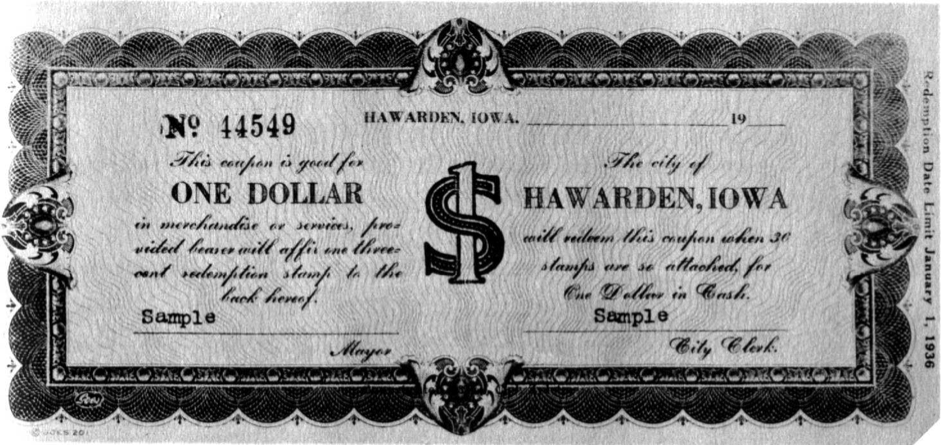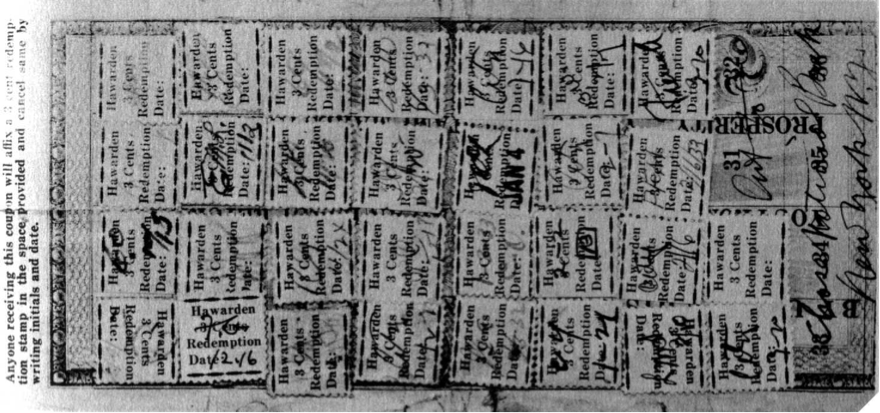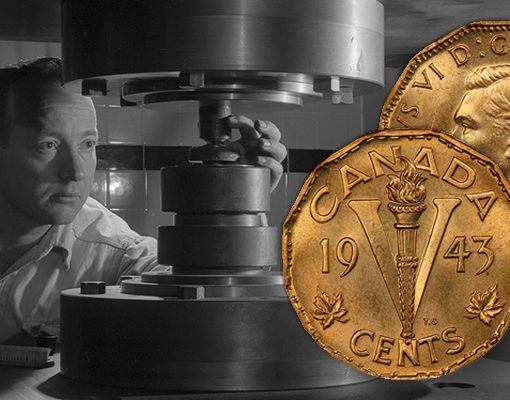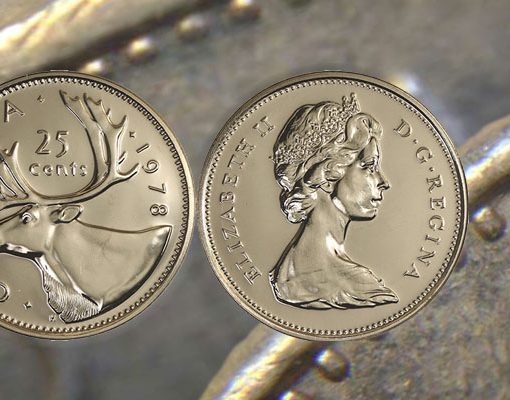The Alberta Prosperity Certificates.
By: MICC Lifetime member #001
Depressions and hard times usually give rise to a number of experiments designed to alleviate the distress, with those concerning money in the van. The “Dirty Thirties” in Canada and the U.S. were no exceptions and while various forms of “Depression Scrip” were expected, perhaps the most spectacular were the “Alberta Prosperity Certificates” issued by the Social Credit government of William Aberhart in 1936.
William “Bible Bill” Aberhart was a Calgary school principal who made a following for himself by the use of radio, broadcasting a Sunday program for the Prophetic Bible Institute, the fundamentalist flavour of which resonated well at the time with Alberta’s largely rural population. In about 1932, Aberhart discovered and adopted whole-hog the economic teachings of one Major Clifford Hugh Douglas, a philosophy that Douglas termed “Social Credit”. Quite frankly, no one has ever been able to exactly figure it out – including Aberhart as later events show – but the emphasis on international conspiracies by “them” and the preaching of wealth-sharing sounded good to Albertans caught in the snares of the Depression. Douglas himself was an anti-Semite with ties to the British Fascist Party and while Aberhart was neither, it’s hard to decide just where Aberhart did stand politically. No friend of banks and distrusted by business, he still had definite authoritarian leanings and, in the back rooms, his advisors ranged all across the political spectrum.
Douglas was mildly aghast that the main disciples of his teachings were these “Prairie wild men” and was not long in severing all ties with them. “Social Credit” manifested itself in the “Alberta Prosperity Certificates”, which was actually an example of “put up or shut up” and proved to be less than successful.
The Antecedents.
Back in the 1890s, a German expatriate named Silvio Gessell operated a store in Argentina and went broke during one of their depressions. To Gessell, it didn’t make sense that this could happen in a country with all the natural resources Argentian had and his musings led him to propound a most unusual (and erroneous) economic theory. It was his belief that while goods deteriorated, money did not – but if it did, the balancing out would be beneficial to all. Central to this conclusion was his belief that depressions and crashes were caused by non-circulating money; that it was just sitting in bank vaults. Therefore, he proposed forcing money to circulate.
His scheme consisted of currency that kept its value for only one year – and then depreciated by 10%. He proposed that in Year One, the notes be printed in a given colour; in Year Two, the colour changed and the notes of the previous year to now pass at only 90% face. This would continue until Year 10 when those of Year One would become worthless and the same colour able to be used all over again. Naturally, everyone would be frantically attempting to pawn off currency that was due to be discounted – hence, a currency circulating at “warp speed”.
But the whole philosophy was based on the fallacy of “resting money”; banks do not keep it secreted in vaults but rather send it out in the form of loans and investments, with the hopeful result that it will earn profits by its labour.
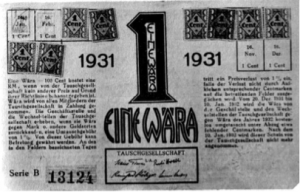
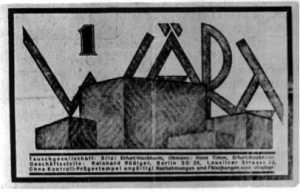
Above: A “eine (1) Wara” note used in a number of small German towns in 1931.
This one was actually used although outlawed in late 1931.
Gessell’s theories were adopted by an Austro-Germanic group calling themselves the “Freiland-Freigeld Bund” and, during the 1920s, circulated highly limited issues of notes among Bund members, all such notes fully backed by Reichsmarks but which required a monthly stamp on each (equal to 1% face) to maintain their full value. These notes circulated in a very hit-and-miss fashion for about six years before the Depression struck.
These hard times gave the Bund opportunities to experiment on a larger scale. In the town of Schwanenkirchen in Bavaria, with a population of about 500, the economic mainstay – a mine – had been closed in 1929. In 1931, the owner succeeded in obtaining a loan of 40,000 Reichsmarks to re-open it and, at the urging of the Bund, he issued as miners’ pay not government banknotes but rather a special issue denominated in “Wära” (roughly translating “commodity” or “stock”). As the above illustration shows, each provided for a monthly stamp so that it might retain its full value. The reason for this was to stimulate rapid circulation and discourage hoarding – although why there should be any need for either by a population unemployed for two years was never explained.
The notes were accepted by the town’s merchants (since there was little other money) but were refused outside it except for a few thousand stores scattered across Germany, all of whom were Bund members. While termed a success by the Bund, regular notes would surely have served as well. In any case, they were declared a trespass on federal jurisdiction and outlawed by an emergency law in November, 1931.
A similar scheme was tried in nearby Austria at nearly the same time. Backed in part by a local bank account drawing 6% interest, Mayor Unterguggenberger of Worgl organized a system of public works to take 1500 off the dole in August, 1932. For payment, the town issued 32,000 schillings in “Wära” notes, merchants forced to accept them since there was nothing else. They were, however, acceptable at the local savings bank and the municipal tax office. Actually, they were a loan to the town made by themselves, the “real” money plus outstanding special notes earning 12% for them. At the time of issue the town coffers were in arrears by 118,000 schillings but this dropped
to 39,000 schillings by the next April. However, suit was brought against the town by the Austrian National Bank in August, 1933 and the notes prohibited.
During the Depression, various U.S. municipalities issued several types of scrip: tax anticipation warrants and scrip backed by Clearing House Associations and Chambers of Commerce had both been used before. But this time, some 18 towns in 10 states also issued “semi-Gessell” stamped money. That illustrated below was first issued in Hawarden, Iowa in October, 1932. In a town of 3,000, it was a limited issue: only $300 worth in $1 denominations. Workers on relief projects were offered this scrip on the basis of one such note for each 60-cents (cash) owed them by the town. The sticky part was that at each purchase, the tenderer was forced to buy and apply a 3-cent stamp, the receiver then dating and cancelling it by pen. After 36 transactions, when $1.08 in stamps
Above: Stamped money used in Hawarden, Iowa, in 1932/3.
A Dollar note, each stamp on the reverse was equal to 3-cents, payable at each transaction.
had been applied, the notes were retired. In effect, this was a municipal sales tax of 3%. As a local self-help project, there was no federal objections to it although all such issues were later swept away by Roosevelt’s New Deal policies.
The Canadian Experiment.
Unable to cope with the effects of depression and drought, the United Farmers Party was turfed out of Alberta in the summer of 1935 and replaced by Aberhart’s Social Credit Party. In great part, the win was due to Aberhart’s promise to pay every adult Albertan $25 per month as a “national dividend” out of the “Social Credit” – with lesser amounts payable to each child.
The trouble was that there was no money to make good this promise. Not only was the Alberta Treasury bare, it was to default on the payment of $9-million worth of its bonds from this time to the end of 1938. Casting about for the needed funds, Aberhart contacted Major Douglas himself for suggestions.
Douglas was unrealistic. It was his proposal that the banks be asked to make a loan of $5-million to the province, interest-free and uncallable, in return for a service charge of 1.5%. Since the banks might be understandably reluctant to finance their own demise, his next suggestion was to “get” all Albertan holders of stocks and bonds to exchange them for the province’s own short-dated notes, bearing 1% – but with the original holders continuing to collect such dividends and interest as would accrue while not being able to sell the instruments themselves. Aberhart’s restrained refusal of these suggestions set the Major off in a huff; he was on his own.
1935 turned into ’36 and the “national dividend” was still nowhere in sight, causing even some of Aberhart’s backbenchers to become restive. Aberhart often vacationed on the West Coast and on one of these trips in early 1936, he met E.S. Woodward, another economic expert and a Gessellite. Upon his return on April 23, 1936, Aberhart announced that the promise would be kept by means of an issue of scrip and immediately set out on a speaking tour around the province, trumpeting its merits and imploring everybody – merchants, town councils and all – to freely accept it.
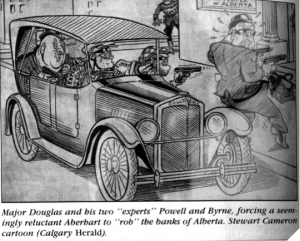
But there was great deal of opposition to the scheme, not the least of which was from the holders of provincial bonds on which the interest payments had been recently defaulted. Nor was there unanimity even in the government: some members wanted the scrip given out as the promised “national dividend” while Woodward strenuously objected since it would bankrupt the treasury. On the other hand, he also found it objectionable that the government would not accept its own scrip in payment of taxes, fines or alcohol. Aberhart was determined to keep the scrip out of the treasury and in circulation – as well as its use for immediate payments rather than pump-priming handouts. Woodward issued an ultimatum and was fired.
Therefore, it was under the Social Credit Measures Act (Statutes of Alberta, I Edward VIII, 1936, Chapter 8) that the “Alberta Prosperity Certificates” were born. All in 1-Dollar denominations, two billion dollars’ worth were authorized but only some 500,000 were actually printed by Abe Shnitka, the King’s printer (appearing as Western Printing and Lithographing Co. Ltd., Calgary). Different references vary as to how many actually circulated: 262,00 (Myers) or 357,680 (Charlton).
It must have also come as something of a shock to Albertans to find that the current holders of such notes were forced to affix a 1-cent stamp weekly for the note to be valid. Since there were spaces for 2-years’ worth of such stamps (104 of them), it seems evident that Aberhart would have the public pay for their own money piecemeal – with 4-cents left over for expenses.
The first recipients were workmen engaged in work-relief road-building programs and while merchants were pleased to see payments made on overdue accounts, they were less pleased to find that the notes were unacceptable to their suppliers, banks and many of the larger department store chains. At first, the notes were allowed to be redeemed by the provincial government in Canadian currency by merchants making payments outside the province but soon public confidence forced the notes to be redeemable at any time for Canadian notes. The results were predictable: first issued on August 5, 1936, roughly half of the total had been redeemed by September 30 and by November 14, only $36,000 worth remained outstanding. By April/May, 1937, the scheme went under with 19,639 (Charlton) or 12,000 (Myers) of the notes never redeemed.
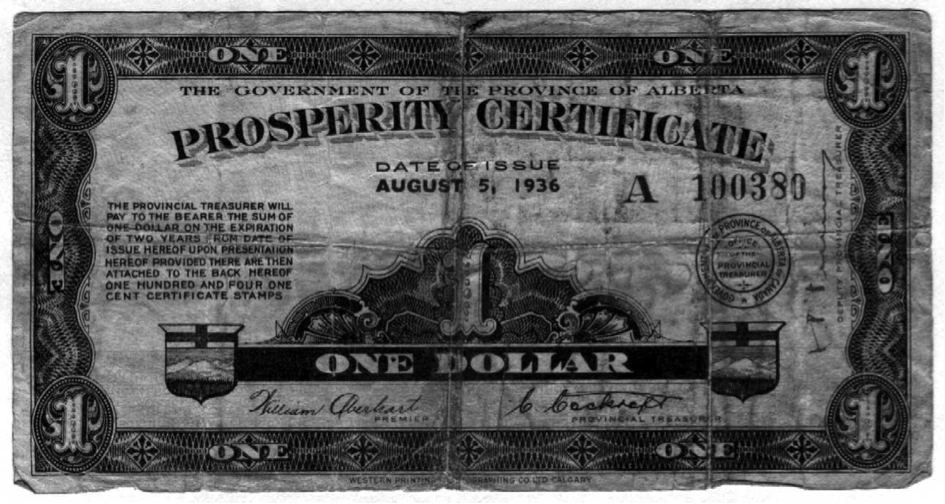
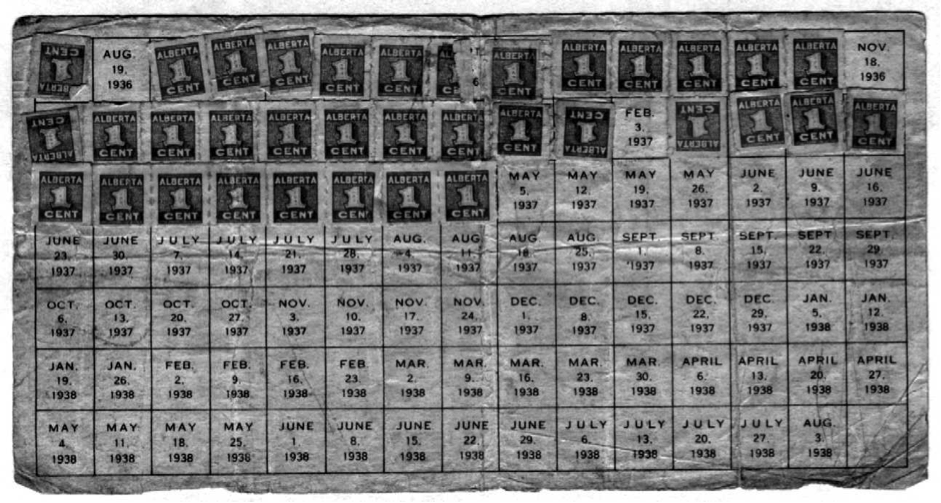
Above: Alberta Prosperity Certificate with stamps to late April, 1937.
One of the longer-used examples of the Certificates, some stamps have fallen off – a constant complaint – and other stamps have been applied in multiple-strips, showing that the notes did not constantly circulate, the last owner forced to play catch-up and buy the necessary stamps..
Following on the heels of the issue of the Prosperity Certificates was a second controversial piece of legislation: the “Registration Covenant”. As”explained” on August 31, 1936, all Albertans who wished to receive the “national dividend” were to sign a covenant (i) agreeing to make no claim on the provincial government for Canadian currency, (ii) to make all payments to the Alberta government in Canadian currency, (iii) to disclose all assets, liabilities and personal information, (iv) farmers to sell a minimum of 50% of their produce for “Alberta Credit” and (v) those leaving the province for more than one month to have permission from the manager of the State Credit House. These would be local institutions that would act as banks and clearing houses. The province advertised for the positions and such positions were over-subscribed but, as things turned out, nothing of the above ever came about, except for a few “credit unions”.
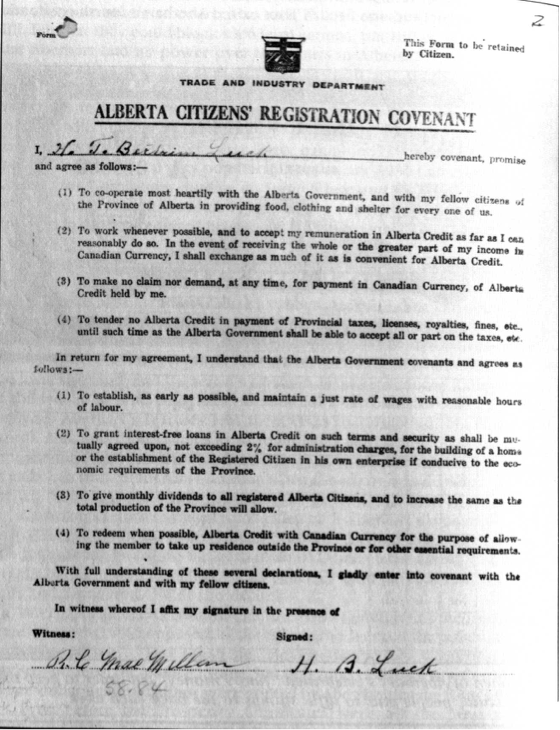
The Alberta Citizen’s Registration Covenant, 1936.
Signed by “H.B. Luck”, it was the belief this would lead to payments of $25 per month from the “national credit”. Nothing was ever received through the program.
Even more extraordinary was legislation that fall embodied in some 16 Acts as “Statutes of Alberta, 1 Edward VIII, Session II, 1936, Act – .” These acts legalized the registration program, established the State Credit Houses and granted broad powers to the government for “further development”; cancelled all interest payments on debts contracted before July, 1932 and established a body to rule on property seizures and repayments; granted the “Debt Adjustment Boards” sweeping, unappeable powers; legalized the Prosperity Certificates as well as the government’s 50% reduction in interest payments on bonds and savings certificates; made members of the Executive Council immune from prosecution or legal action due to any of their legislation retroactive to September 1, 1935.
But it was not to be. The Canadian federal government reserved to itself all matters pertaining to currency, banking, trade and commerce as well as the supremacy of the Supreme Court over provincial legislation. Practically all of Aberhart’s acts had been struck down by late 1938.
Previously printed in the MICC Numismatic Journal Vol-02, Issue-12

